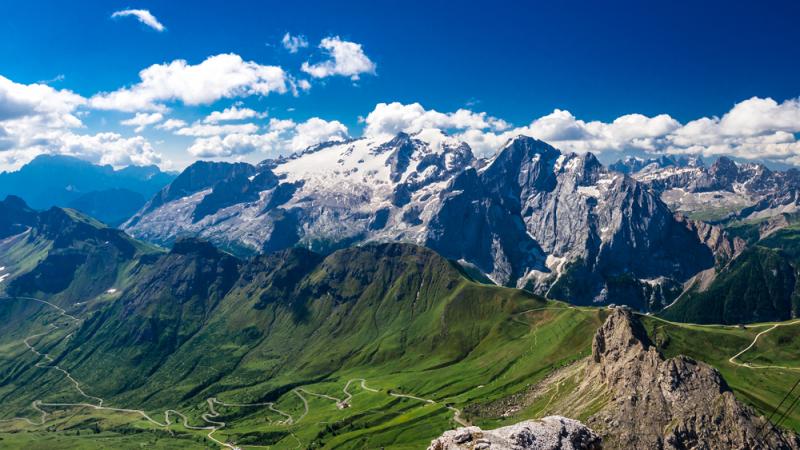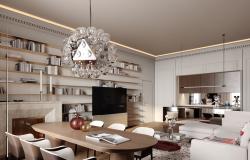Surrounded by some of the most spectacular Dolomites peaks, the tiny village of Arabba stands in an ideal position to explore these Unesco-inscribed mountains, which Reinhold Messner, the greatest mountaineer alive, has described as the most beautiful in the world.
Arabba, located at the foot of the Sella group, is the main resort town of the Valley of Fodom, one of five Ladin valleys of the Dolomites (Ladin is an ancient culture that is unique to the Dolomites; the Ladin people have their own language, traditions and even their own cuisine).
Arabba is a favorite destination for summer hiking and mountain biking thanks to its proximity to many famous groups, peaks and valleys of the Dolomites, such as the Sella group, the Marmolada, Col di Lana, the Alta Badia valley, and the Lagazuoi-5 Torri area, among others, where hiking and biking trails, immersed in the woods or on rocky terrain, offer something for everyone, from families to adventure seekers.

['La bella Arabba!' (Beautiful Arabba), as the writer's friend kept saying of this mountain village in the heart of the Dolomites.]
The Strada Statale 48 delle Dolomiti (SS48), a scenic road built between 1901 and 1909 to connect the city of Bolzano in South Tyrol with Cortina d’Ampezzo in Veneto, at the time a main factor for the development of tourism in the area, passes through Arabba and leads to two main passes, Passo Pordoi to the west and Passo Falzarego to the east, both starting points for excursions.
I began my week of Dolomites hiking with the ascent to Piz Boè, at 3,152 metres (10,341 ft) the highest peak of the Sella group (the Sella lies between the four Ladin valleys of Badia, Gherdëina, Fascia, and Fodom and is divided between the provinces of South Tyrol, Trentino and Belluno).
I opted for reaching Piz Boè on foot from the Pordoi Pass (2,239 m -7,346 ft), a 20-minute drive from Arabba via 33 hairpin turns, which can prove hard on any stomach.
The hiking path gets steep rather quickly, and, as soon as you start hiking up, you’ll have great views of the Marmolada, the Catinaccio, and the Sella itself, looming right above you, as you make your way up to Rifugio Forcella Pordoi (2848m) through a rather impressive saddle sandwiched between vertical walls. From there, the landscape takes on a lunar aspect, all rocks and gravel, with enchanting views all around.
Once you reach the top of Piz Boè, you’ll be rewarded with a 360° view over the Dolomites of the Fassa and Gardena valleys and the Cortina d’Ampezzo area, and you can see Arabba down in the valley below; you can celebrate with beer or anything of your liking at the Capanna Piz Fassa hut which stands right on top of the mountain.
Those who prefer a less challenging hike to the top can take advantage of the cable car at the Pordoi Pass, which takes up to Sass Pordoi, 2952m, saving a 700-meter elevation gain. Be prepared for crowds if you go in high season – I went on Ferragosto day and, on the last stretch of the hike, because the trail gets narrow and steep, I had to wait in line to be able to proceed, something I extremely dislike on a mountain.

[The trail leading to Piz Boè, the highest peak of the Sella group in the Dolomites.]
A more relaxed walk which still affords great views also begins at the Pordoi Pass: it’s the Viel del Pan path. Viel del Pan is a Ladin name that means ‘route of bread’, as this path is a historic route that was used by convoys transporting goods from the nearby Fassa Valley to the Cordevole Valley; it was considered safer than the valley bottom.
After an initial short ascent leading to the tiny church of Pordoi, the path levels out and continues on flat terrain on the 2,400-meter-high ridge between the Sella and the Marmolada, with increasingly better views of the Marmolada, the so-called ‘queen of the Dolomites,’ because it boasts the highest Dolomites peak, Punta Penia, 3,343 m (10,968 ft). Its glacier is still the largest in the Dolomites, but has been visibly affected by rising temperatures; my friend’s father, who has vacationed in the area for decades, said he could see the glacier sliding down the side of the mountain much lower than it does today. Indeed, over the course of a century, its size has more than halved: it measured 450 hectares in 1910, now it measures 190.

[The Marmolada glacier during World War I, 1915-18.]

[The Marmolada glacier in summer 2018. Notice how it has shrunk. Photo by Silvia Donati.]
You’ll pass several mountain huts along the Viel del Pan trail, a welcome opportunity to taste the local cuisine and grappas.
For more viewing angles on the queen of the Dolomites, do the hike that starts at Malga Ciapela toward Rifugio Falier. This path affords impressive views over the south wall of the Marmolada because you’ll be standing right below it. Along the way, make sure to stop at Malga Ombretta, famous, and rightly so, for its yogurt and cheese made on the premises. Rifugio Falier offers great food under the imposing walls of the Marmolada and of the quite bizarre Fungo d’Ombretta. On the way back, walk through the Vallon dell’Ombretta where you’re likely to hear the whistles of marmots.

[The delicious yogurt from Malga Ombretta, a must-try! Photo by Silvia Donati.]
A cable car runs from Malga Ciapela to Punta Rocca (3,265 m), near Punta Penia, the highest peak of the Marmolada. At the end of the second section of the cable car trip (Piz Serauta, 2,950 m), there is a museum dedicated to the First World War, recounting the battles that took place in these mountains, which represented the border between Austria-Hungary and Italy.
A major symbol of the warfare that took place in the Dolomites between 1915 and 1917 is the Col di Lana mountain (2452m). While not among the highest peaks of the area, but because it stands at the geographic center of the Dolomites, Col di Lana offers one of the best views, a 360° panorama over many Dolomites groups, from the Sella to the Marmolada to the Civetta.
Col di Lana can be reached via different paths. The one I took, departing from the Valparola pass, is rather long, and absolutely beautiful, recommended only for experienced hikers, especially because in the last stretch, it goes over rocks, and is aided by fixed chains and iron steps.

[The World War I memorial chapel on top of the Col di Lana mountain.]
During World War I, Col di Lana, alongside the neighboring Monte Sief, was the scene of heavy fighting between Austria-Hungary and Italy. As you hike up Monte Sief to reach Col di Lana, you can see a trench that was built all along the side of the mountain.
The summit of Col di Lana was blasted on the night between the 17 and 18 of April 1917 with five tonnes of dynamite, causing the death of more than 100 men from the Austrian military and opening a large crater that can still be seen today. The explosion however didn’t bring any strategic success to the Italians, who were not able to break through because the Austrians didn’t leave their position on Monte Sief, therefore blocking the Italians’ passing into Trentino.
A memorial chapel stands on the summit of Col di Lana as a memorial to the soldiers who fell in battle.
How to get there:
Arabba can be reached in about two hours by car from the Venice airport. The Belluno, Brunico and Bolzano train stations are the closest. From there, you can take a local bus or book a private taxi service.
Where to stay:
I enjoyed my stay at the family-run Garni Marilena, which is right in the center of Arabba: http://www.hotel-marilena.it/en/hotel-arabba.htm Manuel, the owner, is very courteous and breakfast is fantastic!
For an upscale option, go for the 4* Hotel Evaldo, at the entrance to the village. It features a small but lovely spa area. https://www.hotelevaldo.it/en/hotel-dolomites/1-0.html
Where to eat:
Across the street from Garni Marilena is my favorite place to eat in Arabba, Peter. Traditional dishes and good pizza. http://www.barpeter.it/
Al Table’ also offers a traditional menu, although it is of slightly lower quality. Warm ambiance.
Meat lovers should head to Miky’s Grill, which specializes in grilled meat. http://www.mikysgrill.it/en/restaurant-arabba.htm














